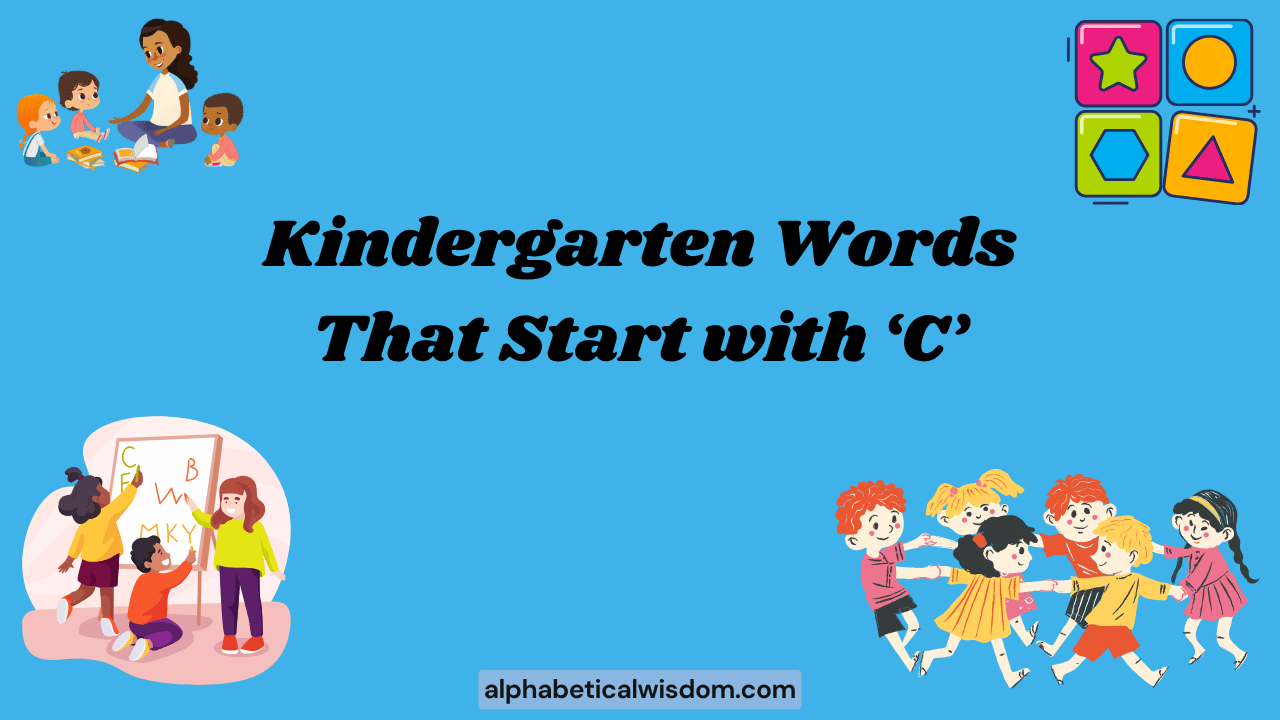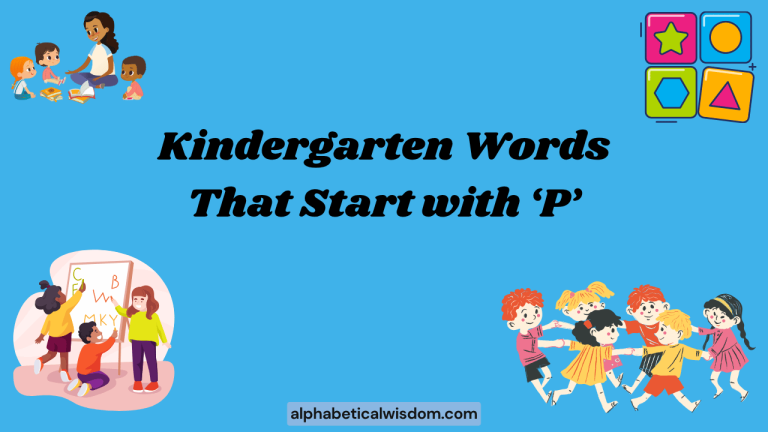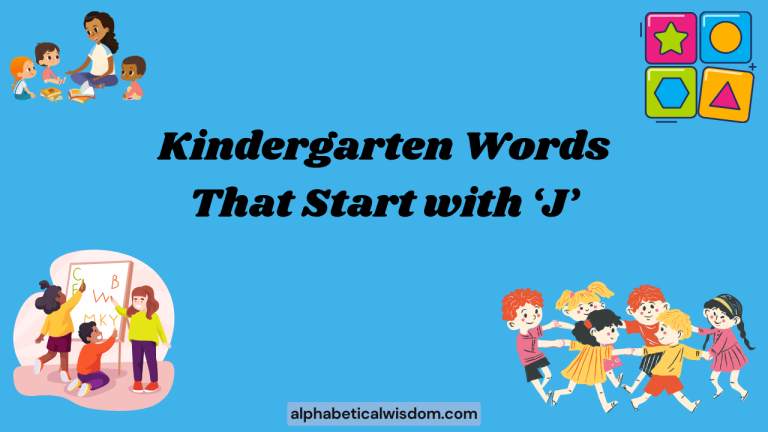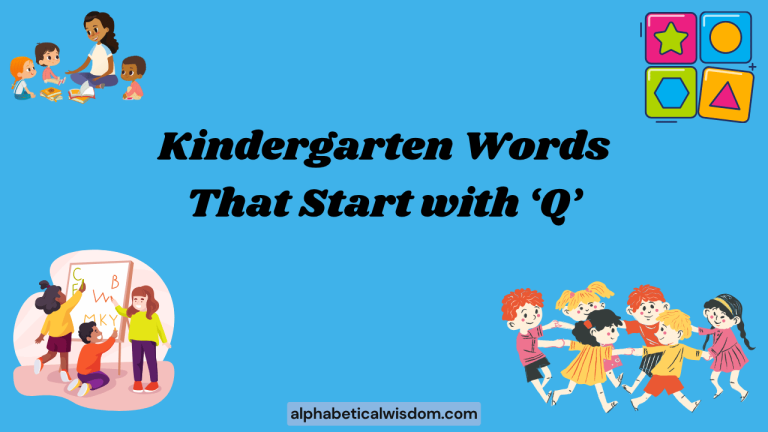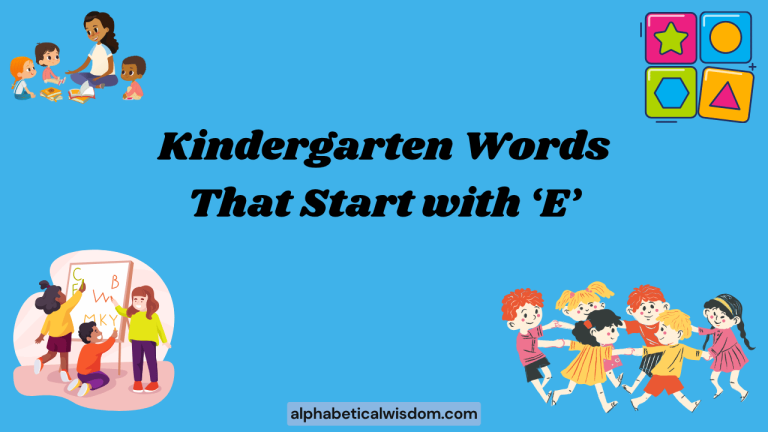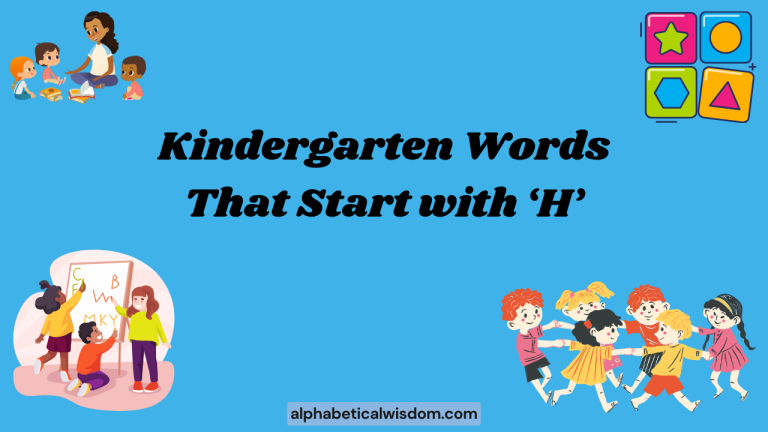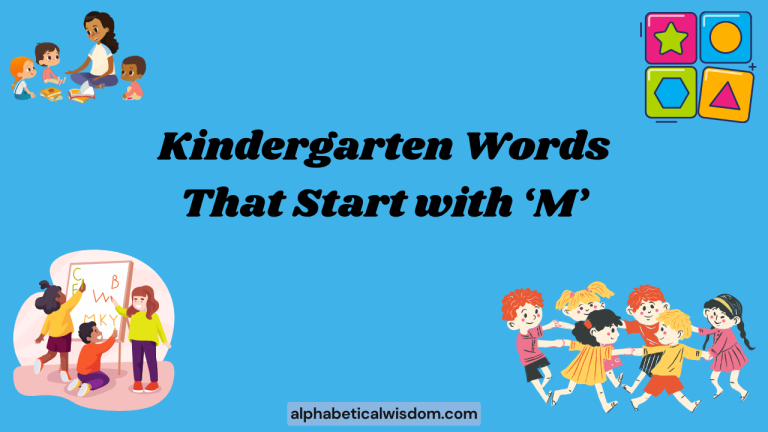Kindergarten Words That Start With C: A Comprehensive Guide
Understanding words that begin with the letter ‘C’ is a crucial step in a child’s early literacy journey. These words form the foundation of their vocabulary, aiding in reading comprehension, writing skills, and overall communication.
This article provides a comprehensive exploration of kindergarten-level words starting with ‘C’, offering definitions, examples, usage rules, and practice exercises. This resource is perfect for parents, teachers, and young learners looking to master these essential words.
Table of Contents
- Introduction
- Definition of Kindergarten ‘C’ Words
- Structural Breakdown of ‘C’ Words
- Types and Categories of ‘C’ Words
- Examples of Kindergarten ‘C’ Words
- Usage Rules for ‘C’ Words
- Common Mistakes with ‘C’ Words
- Practice Exercises
- Advanced Topics
- FAQ Section
- Conclusion
Introduction
The letter ‘C’ is a versatile consonant that introduces a plethora of words essential for kindergarteners. Mastering these words enhances their reading fluency, writing accuracy, and overall communication abilities.
This article provides a detailed guide to kindergarten words starting with ‘C’, offering definitions, structural analyses, examples, and practical exercises. It’s designed to be a valuable resource for educators, parents, and young learners embarking on their literacy journey.
By exploring these foundational words, children build a strong base for future language development.
Definition of Kindergarten ‘C’ Words
Kindergarten words starting with ‘C’ are vocabulary terms suitable for children aged 4-6, typically encompassing simple nouns, verbs, and adjectives. These words are characterized by their phonetic simplicity and relevance to a child’s everyday experiences.
They introduce fundamental concepts and objects, helping children understand and interact with their environment. The ‘C’ sound can be either hard (as in “cat”) or soft (as in “city”), adding a layer of complexity that children learn to distinguish early on.
The function of these words is primarily to build a basic vocabulary that allows children to express themselves and understand simple instructions. They also serve as building blocks for more complex language structures encountered in later grades.
Understanding these words is crucial for early reading comprehension and writing skills, enabling children to decode text and construct simple sentences.
Structural Breakdown of ‘C’ Words
Many ‘C’ words for kindergarteners follow simple consonant-vowel-consonant (CVC) patterns, such as “cat,” “cup,” and “cot.” These structures are easy for children to decode phonetically. Other words may include digraphs (two letters representing one sound), such as “ch” in “chair” or “ck” in “clock.” Understanding these patterns helps children recognize and pronounce new words more easily.
The letter ‘C’ can represent two different sounds: a hard ‘C’ (like /k/) and a soft ‘C’ (like /s/). The pronunciation depends on the letter that follows ‘C’.
If ‘C’ is followed by ‘e’, ‘i’, or ‘y’, it usually makes the soft ‘C’ sound (e.g., “cent,” “city,” “cycle”). If ‘C’ is followed by any other letter, it usually makes the hard ‘C’ sound (e.g., “cat,” “cup,” “cow”).
This rule is fundamental for children to grasp early in their reading development.
Types and Categories of ‘C’ Words
Nouns
Nouns are words that represent people, places, things, or ideas. Kindergarten ‘C’ nouns often refer to common objects and animals familiar to children.
Verbs
Verbs are words that describe actions or states of being. ‘C’ verbs for kindergarteners typically involve simple actions that children perform or observe.
Adjectives
Adjectives are words that describe nouns, providing more details about their qualities. ‘C’ adjectives help children develop descriptive language skills.
Adverbs
Adverbs are words that describe verbs, adjectives, or other adverbs, indicating how, when, where, or to what extent something is done. While less common in early kindergarten, some simple ‘C’ adverbs might be introduced.
Examples of Kindergarten ‘C’ Words
Nouns Examples
The following table provides examples of kindergarten-level nouns that start with the letter ‘C’. These nouns are commonly used in early childhood education and are designed to be easily recognizable and relatable for young learners.
They include objects, animals, and concepts that are part of a child’s everyday experience.
| Word | Definition | Example Sentence |
|---|---|---|
| Cat | A small domesticated carnivorous mammal with soft fur. | The cat is sleeping on the mat. |
| Cup | A small container used for drinking. | I drink water from my cup. |
| Car | A road vehicle, typically with four wheels, powered by an internal combustion engine. | My dad drives a red car. |
| Cake | A sweet baked food made from flour, sugar, and other ingredients. | We ate chocolate cake at the party. |
| Cow | A fully grown female animal of a domesticated breed of ox, kept for its milk or meat. | The cow gives us milk. |
| Coat | An outer garment worn to keep warm or dry. | I wear my coat when it’s cold. |
| Comb | A toothed strip of plastic, metal, or bone used for untangling or arranging the hair. | I use a comb to brush my hair. |
| Corn | A tall plant grown for its yellow grains. | We ate corn on the cob. |
| Crown | A ceremonial headdress worn by a monarch as a symbol of authority. | The queen wore a beautiful crown. |
| Class | A group of students who are taught together. | Our class is learning about animals. |
| Chair | A seat for one person, typically with a back and four legs. | Please sit in the chair. |
| Clock | An instrument for measuring and showing time. | The clock is ticking on the wall. |
| Cloud | A visible mass of condensed water vapor floating in the atmosphere. | I see a fluffy cloud in the sky. |
| Candy | A sweet food made with sugar or syrup, often flavored with fruit, chocolate, or other ingredients. | I love eating candy on Halloween. |
| Camera | An apparatus for taking photographs or recording video. | I took a picture with my camera. |
| Castle | A large building, typically of the medieval period, fortified against attack. | The prince lives in a big castle. |
| Cave | A large underground chamber, typically of natural origin. | The bear lives in a dark cave. |
| City | A large town or urban area. | I live in a big city. |
| Crayon | A stick of colored wax used for drawing. | I drew a picture with a red crayon. |
| Cookie | A sweet baked treat, typically small and flat. | I ate a chocolate chip cookie. |
| Cousin | A child of one’s aunt or uncle. | My cousin came to visit me. |
| Circle | A round plane figure whose boundary consists of points equidistant from the center. | Draw a circle on the paper. |
| Camp | A place where people live temporarily, often in tents. | We went to camp last summer. |
| Chicken | A domestic fowl kept for its meat and eggs. | The chicken laid an egg. |
| Chin | The protruding part of the face below the mouth. | I have a small chin. |
Verbs Examples
The verbs listed below are suitable for kindergarteners and are commonly used to describe actions related to daily activities, play, and basic interactions. These verbs help children express what they are doing or observing, thereby enhancing their ability to communicate effectively.
| Word | Definition | Example Sentence |
|---|---|---|
| Come | To move or travel toward a place or person. | Please come here. |
| Can | To be able to do something. | I can run fast. |
| Count | To determine the total number of objects. | Let’s count the apples. |
| Clap | To strike the palms of one’s hands together with a sudden explosive sound. | We clap after the show. |
| Cook | To prepare food by heating it. | My mom will cook dinner. |
| Carry | To support and move (someone or something) from one place to another. | I carry my books to school. |
| Catch | To intercept and hold (something thrown, propelled, or dropped). | I can catch the ball. |
| Clean | To make (something) free of dirt, marks, or mess. | I clean my room every week. |
| Color | To apply color to (something) with crayons, pencils, or paint. | I like to color pictures. |
| Cry | To shed tears, typically as an expression of distress, pain, or sorrow. | Babies cry when they are hungry. |
| Chase | To pursue someone or something in order to catch them. | The dog chases the ball. |
| Chew | To bite and grind (food) in your mouth so it can be swallowed. | I chew my food before swallowing. |
| Climb | To go or come up (a slope or staircase). | I like to climb trees. |
| Close | To move (something) so as to cover an opening; shut. | Please close the door. |
| Collect | To gather together or accumulate. | I collect stamps. |
| Copy | To produce something similar or identical to. | I will copy your drawing. |
| Crawl | To move on one’s hands and knees. | Babies crawl on the floor. |
| Create | To bring (something) into existence. | I want to create a painting. |
| Cut | To divide into pieces with a sharp implement. | I cut the paper with scissors. |
| Change | To make or become different. | The leaves change color in the fall. |
| Chat | To talk in a friendly and informal way. | We chat with our friends. |
| Choose | To pick out or select (someone or something) as being the best or most appropriate of two or more alternatives. | I will choose the red apple. |
| Circle | To move all the way around (something). | The birds circle the tree. |
| Continue | To persist in doing something. | Please continue reading the story. |
| Cover | To place something over or in front of (something else). | I will cover the dish with a lid. |
Adjectives Examples
These adjectives are commonly used in kindergarten to describe objects, people, and situations that children encounter in their daily lives. They help children expand their vocabulary and develop their descriptive abilities, enabling them to express themselves more clearly and effectively.
| Word | Definition | Example Sentence |
|---|---|---|
| Cute | Attractive in a pretty or endearing way. | The kitten is very cute. |
| Clean | Free from dirt, marks, or stains. | My hands are clean after washing. |
| Cold | Of or at a low or relatively low temperature. | It is cold outside today. |
| Calm | Not showing or feeling nervousness, anger, or other emotions. | The sea is calm today. |
| Clever | Quick to understand, learn, and devise or apply ideas; intelligent. | She is a clever student. |
| Colorful | Full of color or having many colors. | The flowers are very colorful. |
| Cool | Fashionable or attractive. | That is a cool car. |
| Curious | Eager to know or learn something. | The child is very curious about the world. |
| Crazy | Wildly enthusiastic or excited. | The party was crazy fun. |
| Certain | Known for sure; established beyond doubt. | I am certain I locked the door. |
| Chubby | Plump and rounded. | The baby has chubby cheeks. |
| Cheerful | Noticeably happy and optimistic. | She is always cheerful in the morning. |
| Classic | Judged over a period of time to be of the highest quality and outstanding of its kind. | That is a classic story. |
| Comfortable | Providing physical ease and relaxation. | This chair is very comfortable. |
| Complete | Having all the necessary or appropriate parts. | The puzzle is complete. |
| Confused | Unable to think clearly; bewildered. | I am confused by the instructions. |
| Content | In a state of peaceful happiness. | I am content with my life. |
| Convenient | Fitting in well with a person’s needs, activities, and plans. | The store is conveniently located. |
| Courageous | Not deterred by danger or pain; brave. | The knight was very courageous. |
| Creative | Relating to or involving the use of the imagination or original ideas to create something. | She is a creative artist. |
| Crisp | (of food) firm, dry, and brittle. | The apple is crisp and delicious. |
| Cruel | Willfully causing pain or suffering to others, or feeling no compassion towards them. | It is cruel to hurt animals. |
| Cultured | Characterized by refined taste and manners and a good education. | She is a very cultured person. |
| Cumbersome | Large or heavy and therefore difficult to carry or use. | The box is too cumbersome to lift. |
| Curly | (of hair) having a twisted, ringlet, or spiral shape. | She has curly hair. |
Usage Rules for ‘C’ Words
The primary rule to remember is the pronunciation of ‘C’ depending on the following letter. As mentioned earlier, a hard ‘C’ sound (/k/) occurs before ‘a’, ‘o’, ‘u’, and consonants (e.g., “cat,” “cow,” “cup,” “crab”).
A soft ‘C’ sound (/s/) occurs before ‘e’, ‘i’, and ‘y’ (e.g., “cent,” “city,” “cycle”).
Another important rule is understanding the use of ‘ck’ at the end of words. This digraph is often used after a short vowel sound to ensure the hard ‘C’ sound is retained (e.g., “back,” “neck,” “tick”).
This helps avoid confusion with words that might otherwise end with a soft ‘C’ sound.
Common Mistakes with ‘C’ Words
One common mistake is confusing the hard and soft ‘C’ sounds. For example, children may mispronounce “city” with a hard ‘C’ sound.
Another frequent error is misspelling words with the ‘ck’ digraph. Children might write “bac” instead of “back.” These mistakes can be addressed through consistent practice and reinforcement of the pronunciation and spelling rules.
Here are some examples of common mistakes and their corrections:
| Incorrect | Correct | Explanation |
|---|---|---|
| Sity | City | Confusion between ‘s’ and soft ‘c’ sound |
| Kat | Cat | Misunderstanding of spelling |
| Bac | Back | Missing ‘k’ in ‘ck’ digraph |
| Coot | Cute | Confusing similar sounding words |
| Culler | Color | Misspelling due to phonetic similarity |
Practice Exercises
Exercise 1: Identifying ‘C’ Words
Circle all the words that start with the letter ‘C’ in the list below. This exercise helps reinforce the visual recognition of words beginning with the letter ‘C’.
It is a simple and effective way to get children familiar with the initial sound and letter association.
| Word | Starts with ‘C’? | Answer |
|---|---|---|
| Apple | Yes/No | No |
| Cat | Yes/No | Yes |
| Dog | Yes/No | No |
| Cup | Yes/No | Yes |
| Ball | Yes/No | No |
| Car | Yes/No | Yes |
| Elephant | Yes/No | No |
| Cake | Yes/No | Yes |
| Fish | Yes/No | No |
| Cow | Yes/No | Yes |
Exercise 2: Fill in the Blanks
Fill in the blanks with a ‘C’ word from the word bank to complete the sentences. This exercise helps children understand the context in which ‘C’ words are used and encourages them to recall and apply their vocabulary.
Word Bank: cat, cup, car, cake, cow
| Question | Answer |
|---|---|
| The ______ is on the table. | Cup |
| The ______ says “Moo!” | Cow |
| I like to eat ______ on my birthday. | Cake |
| The ______ is sleeping. | Cat |
| My dad drives a blue ______. | Car |
Exercise 3: Hard or Soft ‘C’
Indicate whether the ‘C’ in each word has a hard or soft sound. This exercise helps children differentiate between the two possible pronunciations of the letter ‘C’, which is essential for both reading and spelling.
| Word | Hard or Soft ‘C’? | Answer |
|---|---|---|
| Cat | Hard/Soft | Hard |
| City | Hard/Soft | Soft |
| Cup | Hard/Soft | Hard |
| Cent | Hard/Soft | Soft |
| Corn | Hard/Soft | Hard |
| Cycle | Hard/Soft | Soft |
| Coat | Hard/Soft | Hard |
| Cell | Hard/Soft | Soft |
| Class | Hard/Soft | Hard |
| Cider | Hard/Soft | Soft |
Exercise 4: Spelling ‘C’ Words
Write the correct spelling of the ‘C’ word based on the picture shown. (Note: This exercise would ideally be accompanied by images of the objects).
This exercise focuses on spelling accuracy, helping children connect the visual representation of an object with its correct spelling.
| Picture | Word | Answer |
|---|---|---|
| (Image of a cat) | ____at | Cat |
| (Image of a cup) | ____up | Cup |
| (Image of a car) | ____ar | Car |
| (Image of a cake) | ____ake | Cake |
| (Image of a cow) | ____ow | Cow |
| (Image of a comb) | ____omb | Comb |
| (Image of a clock) | ____lock | Clock |
| (Image of a clown) | ____lown | Clown |
| (Image of a crab) | ____rab | Crab |
| (Image of a crayon) | ____rayon | Crayon |
Advanced Topics
For more advanced learners, explore compound words that start with ‘C’, such as “cupcake” or “cardboard.” Discuss the etymology of certain ‘C’ words and how their meanings have evolved over time. Introduce more complex ‘C’ words like “celebrate,” “community,” and “consider,” explaining their nuanced meanings and usage in various contexts.
These advanced topics will broaden their vocabulary and deepen their understanding of the English language.
Another area to explore is the use of the letter ‘C’ in different dialects and accents. Some accents may pronounce ‘C’ slightly differently, which can be an interesting topic for discussion and comparison.
Understanding these variations can help children appreciate the diversity of the English language and improve their listening comprehension skills.
FAQ Section
- Why is it important for kindergarteners to learn words that start with ‘C’?Learning ‘C’ words is crucial for building a foundational vocabulary, enhancing reading and writing skills, and improving overall communication abilities. It helps children recognize patterns in language and understand the relationship between letters and sounds.
- How can I help my child practice ‘C’ words at home?You can use flashcards, read books that emphasize ‘C’ words, play word games, and encourage your child to use ‘C’ words in everyday conversations. Make learning fun and engaging to keep them motivated.
- What is the difference between the hard and soft ‘C’ sound?The hard ‘C’ sound (/k/) occurs before ‘a’, ‘o’, ‘u’, and consonants. The soft ‘C’ sound (/s/) occurs before ‘e’, ‘i’, and ‘y’. Understanding this rule is essential for correct pronunciation and spelling.
- Are there any exceptions to the hard/soft ‘C’ rule?Yes, there are exceptions. Words like “soccer” and “cello” have a hard ‘C’ sound even though they are followed by ‘e’ and ‘o’ respectively. These exceptions are less common but important to be aware of.
- What are some common mistakes children make with ‘C’ words?Common mistakes include confusing the hard and soft ‘C’ sounds and misspelling words with the ‘ck’ digraph. Consistent practice and reinforcement can help address these errors.
- How can I make learning ‘C’ words more engaging for my child?Use games, activities, and visual aids to make learning fun. Incorporate ‘C’ words into storytelling, drawing, and role-playing activities. Positive reinforcement and encouragement are also key.
- What are some good resources for finding kindergarten-level ‘C’ words?Many online resources, educational websites, and children’s books provide lists of kindergarten-level vocabulary. Look for materials specifically designed for early literacy development.
- How do I teach my child to spell words with ‘ck’?Explain that ‘ck’ is often used after a short vowel sound to maintain the hard ‘C’ sound. Use visual aids and practice exercises to reinforce this rule. Encourage your child to sound out the words and listen for the correct pronunciation.
- Why is the ‘ck’ digraph used in some words instead of just ‘k’ or ‘c’?The ‘ck’ digraph is used to ensure that the preceding vowel maintains its short vowel sound. If only ‘k’ were used, it might suggest a different pronunciation. The ‘ck’ combination is a convention in English spelling to clarify pronunciation.
- Are there any ‘C’ words that are also sight words?Yes, words like “can,” “come,” and “could” are often taught as sight words because they may not follow typical phonetic rules and are frequently encountered in early reading materials. Recognizing these words at a glance improves reading fluency.
Conclusion
Mastering kindergarten words that start with ‘C’ is a foundational step in a child’s literacy development. By understanding the different sounds of ‘C’, recognizing common spelling patterns, and practicing regularly, children can build a strong vocabulary and improve their reading and writing skills.
Remember to make learning fun and engaging, and provide plenty of encouragement along the way. With consistent effort, young learners can confidently navigate the world of ‘C’ words and beyond.
Continue to reinforce these concepts through interactive activities, reading aloud, and providing ample opportunities for children to use these words in their daily lives. The journey of language learning is a continuous process, and building a solid foundation in early literacy will set children up for future success.
Embrace the learning process and celebrate every milestone achieved.
